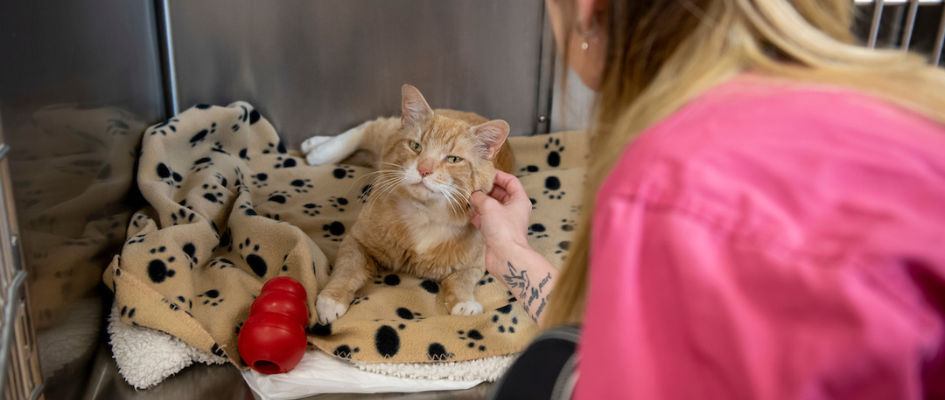Spot-on treatments for cats can be used to treat or prevent a wide range of parasites that can cause irritation, illness, and infection in your pet or in you and your family. Spot-on treatments are usually applied once a month and it’s important to understand how to apply them accurately and safely. Keeping up with your cat’s worm and flea treatment is important if you want to protect them from parasites.
Always check the label before applying it to your pet to make sure it’s the right one for the pet you are treating and using it at the recommended frequency.
Applying the treatment doesn’t have to be complicated. Watch our step-by-step video or follow the steps below.
Top tip: Don’t forget to remove your cat’s collar before you apply the medicine, as it could get in the way of the treatment working correctly.
Guide to applying spot-on flea treatment to your cat
Here at the Goddard Vet Group, we strongly advise using a prescribed monthly spot-on treatment for your cat. You should speak to your vet about the right one for your pet, and make sure that you read the label thoroughly before applying it.
- Simply remove the tube from the packet, and then unscrew the top and use the end of the lid to open the pipette.
- Part the hair and then apply the treatment directly to the skin at the back of your pet’s neck, just above their shoulders. This is so that your pet won’t be able to rub or lick it off. There’s no need to rub it in either, as the treatment will naturally disperse across their skin.
- Most cats will be fine to have their treatment applied whilst resting on their bed or sitting on your lap. However, if not, you can ask someone to gently hold your cat and distract them with some treats whilst you apply the treatment. Using a food paste that they enjoy and can lick while you apply the treatment will help to make it a stress-free experience.
Helpful tips when applying spot-on treatment to your cat
- If any of the treatment transfers onto you, wash it away with soapy water. The solvent in spot-on treatment may stain or damage certain materials including leather, fabrics, plastics, and finished surfaces. Allow the application to dry before permitting contact with such surfaces.
- Make sure you make a note of when your pet’s next treatment is next due, so you can keep them protected.
- For further support in applying your cat’s spot-on treatment, you can watch the video above.

How can Goddard Veterinary Group help?
If you have any questions or concerns about what kind of spot-on treatment your cat should be on, then our vets will be more than happy to advise you. Your pet needs to be protected from a wide range of parasites and we know that it can be overwhelming when choosing which parasite remedies are right for your pet. We can help you by reviewing the risks and offering advice based on your pet’s lifestyle.
Additionally, if your cat has had an adverse reaction to the fleas or the treatment, and you need to see a vet, you can find your local practice here.
Helpful resources
If you would like to know more about the parasites and how to reduce the risk to our cats and family please click on the links below:
- What are fleas and worms?
- The trouble with tapeworm
- Do we need to fear the flea?
- Ectoparasites in Cats
- Endoparasites in Cats – what is inside my cat?
Frequently asked questions
It is important that when applying spot-on treatments for fleas that you apply the treatment to a place where your cat can not reach it. The back of your cat’s neck is the most advised place, this ensures that it cannot be licked off and ingested.
No. A dog’s spot-on treatment used on a cat can prove fatal for the cat. Additionally, a cat spot-on treatment for a dog will not come in a high enough dosage, as dogs are normally larger than cats. Always make sure you use the correct treatment for the correct species.
Spot-on treatment can take up to 24 hours to begin taking full effect and killing the fleas. During this time it is normal to see the fleas on your pet and to notice them jumping about.
Most spot-on treatments need to be administered once per month. With central-heating fleas can still be active in the winter months, so it is important that a regular cycle of treatments is used throughout the year to ensure the protection remains consistent. Before applying the treatment it is important to read the instructions to apply the correct dosage for your cat and at the correct frequency for the brand used.
Not all spot-on treatments protect against ticks. Your vet may recommend a monthly tablet to replace the monthly spot-on, or a collar for the warmer times of the year when tick numbers are high, please ask your vet for more information on protecting your cat from ticks and the incidence in your local area, or areas you plan to travel to with your pet. To learn more about ticks, or how to remove them the PDSA has a very useful guide.
